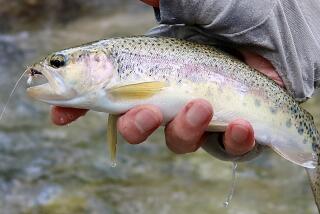New Tactics Used Against Tenacious Pike
Make no mistake: This is a war, and the fish keep winning.
Out on the chilly waters of Lake Davis, state wildlife officials are renewing their fight against the northern pike, the saw-toothed predator with a voracious appetite for just about anything that swims.
Rushing to beat the arrival of winter, which routinely puts a thick sheet of ice over the Sierra lake, wardens last week stretched a 600-foot-long net of wire mesh across an inlet frequented by the pike. A second, longer net will be added this week along a quarter-mile stretch a bit farther out in the lake.
Department of Fish and Game officials hope for now to pen up the bulk of the lake’s pike inside Mosquito Slough, a shallow and weedy estuary where 95% of the pike have been snagged. After the spring thaw, an all-fronts assault will be launched to ensure that the fish do not escape and begin feasting on the state’s fragile salmon and steelhead populations downstream.
“The thinking is [that] most of them are there, and containment is our aim right now,” said Steve Martarano, a Fish and Game spokesman. “Eradication is the ultimate goal, but we’re still looking for that silver bullet.”
Authorities thought they had it two years ago, when the state dumped a poisonous brew into Lake Davis to kill off the fish.
The chemical assault in October 1997 managed to turn all manner of fish belly-up in the lake, which is 40 miles northwest of Reno. It also outraged citizens in nearby Portola, which historically got its drinking water from Lake Davis. Residents were forced to make an emergency switch to well water and complained that the episode crippled the tourist trade that is Plumas County’s economic lifeblood. The state ultimately approved a $10-million settlement to offset the economic loss.
But troubles did not end there. In May, a new group of pike was discovered in Lake Davis, much to the dismay of red-faced state Fish and Game officials. In the months since, more than 300 of the fish, which are not native to the West Coast, have been pulled from the lake. They ranged in size from 4-inch juveniles to a robust adult measuring more than 2 feet long.
Authorities figure the first wave of pike, a popular Midwest sports fish that packs a punch at the end of a fishing line, was spirited into the lake in the early 1990s by some unscrupulous angler. They are unsure of the origins of the latest batch. Fish and Game biologists conducted DNA tests, but failed to answer whether the new pike are the offspring of a few canny poisoning survivors or fresh arrivals brought by human hands.
Local residents and state fishery experts have been weighing scores of possible solutions since summer. Ranging from silly to scientifically grounded, the list has been culled to several finalists that will be discussed at a public meeting in Portola on Monday. A final lineup will probably be reached in January, Martarano said.
Angles of attack being eyed include ultra-fine nets at the lake’s spillway, a pike fishing derby and disruption of their spawning beds. Officials are also looking at trawling the lake with fishing boats to winnow out any pike. And they are cautiously optimistic about the use of detonation cord, which can create an underwater explosion that kills fish within two dozen feet.
The pike remain formidable foes. Aside from being big eaters, pike are among nature’s more effective reproduction machines. The fish can lay up to 9,000 eggs per pound of body weight. A large pike can weigh up to 6 pounds.
Officials are optimistic that simply putting up the double barrier of nets at Mosquito Slough may do more than just fence in the fish. Biologists hope the penned-up pike will turn on their own, dining on young fish they spawn.
Wardens have already been making almost daily forays out onto the waters in boats equipped with an electroshock device that stuns the fish, which are hauled out of the water with nets.
One alternative definitely off the table is the use of rotenone, the chemical employed against the pike two years ago. Authorities are investigating the use of other chemicals, such as chlorine and stone, but any use would require a lengthy approval process through the state and federal health officials.
Fish and Game experts, reluctant to brush aside any solution, also are looking at the possibility of draining the lake, or at least lowering the level to expose pike eggs laid in shoreline muck. Time could be a big constraint on that front--it would take about two years once the plug was pulled. Local officials say they simply will not put up with Lake Davis being emptied, wary of the economic disaster it might unleash.
“The last time the lake was out of commission, the ripple effect to the economy was amazing,” said Jim Murphy, Portola’s city administrator. “We don’t want to go that direction again.”
Once confident that Lake Davis could be rid of its pike problem, state authorities are now talking in more cautious tones. And local residents seem resigned to living with the pike, at least for the near future.
More to Read
Sign up for Essential California
The most important California stories and recommendations in your inbox every morning.
You may occasionally receive promotional content from the Los Angeles Times.








